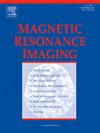双扩散编码MRI的线性旋转不变性峰度测量
IF 2
4区 医学
Q2 RADIOLOGY, NUCLEAR MEDICINE & MEDICAL IMAGING
引用次数: 0
摘要
目的描述双扩散编码(DDE) MRI提供的线性旋转不变性峰度测度的完整集合,展示其在区分不同类型的多高斯隔室(MGC)模型中的效用,并展示其估计的简化采集和分析方案。理论与方法DDE MRI获得的最低阶新信息可以封装在六维峰度张量中。最基本的DDE MRI峰度测量是旋转不变量,它在这个张量中是线性的,而不依赖于其他物理量。我们确定了四个这样的不变量,并证明任何其他不变量必须是这些不变量的线性组合。应用不变量对MGC模型进行分类,根据它们是否包含微观各向异性或室间水交换。此外,它们还用于研究交换对微观分数各向异性(μFA)估计值的影响。提出了简化的不变量获取和分析方案,并用3 t时获得的人脑数据进行了验证。结果对于考虑的大脑区域,发现峰度不变量与具有微观各向异性的MGC模型基本一致。它们还表明灰质中的水交换可能影响μFA的估计值。结论峰度指标可以根据MGC模型是否具有微观各向异性或水分交换性对其进行分类,并且可以通过简单的获取和分析方案进行估计。脑内不变量的测量支持具有微观各向异性的MGC模型的有效性,以及水交换对模拟灰质扩散的重要性。本文章由计算机程序翻译,如有差异,请以英文原文为准。
Linear rotationally invariant kurtosis measures from double diffusion encoding MRI
Purpose
To characterize the complete set of linear rotationally invariant kurtosis measures provided by double diffusion encoding (DDE) MRI, show their utility in distinguishing different types of multiple Gaussian compartment (MGC) models, and demonstrate simplified acquisition and analysis schemes for their estimation.
Theory and methods
The lowest order novel information obtainable with DDE MRI can be encapsulated in a six-dimensional kurtosis tensor. The most basic DDE MRI kurtosis measures are rotational invariants that are linear in this tensor while depending on no other physical quantities. We identify four such invariants and show that any others must be linear combinations of these. The invariants are applied to classify MGC models according to whether they include microscopic anisotropy or intercompartmental water exchange. In addition, they are used to investigate the effect of exchange on estimates of the microscopic fractional anisotropy (μFA). Simplified acquisition and analysis schemes for the invariants are proposed and demonstrated with human brain data obtained at 3 T.
Results
For the considered brain regions, the kurtosis invariants are found to be largely consistent with MGC models having microscopic anisotropy. They also indicate that water exchange in gray matter may affect estimates of μFA.
Conclusion
The kurtosis measures can classify MGC models according to whether they have microscopic anisotropy or water exchange, and they can be estimated with simple acquisition and analysis schemes. Measurements of the invariants in brain support the validity of MGC models with microscopic anisotropy and the importance of water exchange for modeling diffusion in gray matter.
求助全文
通过发布文献求助,成功后即可免费获取论文全文。
去求助
来源期刊

Magnetic resonance imaging
医学-核医学
CiteScore
4.70
自引率
4.00%
发文量
194
审稿时长
83 days
期刊介绍:
Magnetic Resonance Imaging (MRI) is the first international multidisciplinary journal encompassing physical, life, and clinical science investigations as they relate to the development and use of magnetic resonance imaging. MRI is dedicated to both basic research, technological innovation and applications, providing a single forum for communication among radiologists, physicists, chemists, biochemists, biologists, engineers, internists, pathologists, physiologists, computer scientists, and mathematicians.
 求助内容:
求助内容: 应助结果提醒方式:
应助结果提醒方式:


